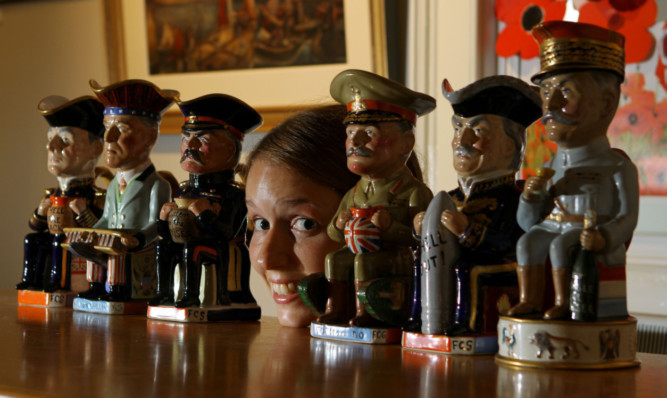A trove of First World War memorabilia is on display in a Tayside museum.
Some of the most recognisable figures from the conflict were preserved as Toby jugs by cartoonist Sir Francis Carruthers Gould between 1915 and 1920.
A collection have gone on display at the Signal Tower Museum in Arbroath and will be open to the public until September 30.
Curator Colin Easton said: “Some of the best ceramic memorabilia items ever made were limited edition Toby jugs of First World War political and military leaders.
“They were designed between 1915 and 1920 by Sir Francis Carruthers Gould. Gould was a well-known cartoon artist and his designs were popular at the time.”
The jugs were produced by Arthur J Wilkinson of Royal Staffordshire Pottery. Public opinion was mixed about some of the leaders commemorated by Gould’s series of jugs.
Lord Horatio Kitchener was Secretary of State for War from 1914 to 1916, when he was one of 600 who drowned when HMS Hampshire struck a mine laid by a German U-boat.
Sir John French was a field-marshal and Commander-in-Chief of the British Expeditionary Force at the outbreak of war, before he was forced to resign in 1915 after costly losses.
The most divisive figure among modern British military historians for some decades, Field Marshal Sir Douglas Haig was commander during the Battle of the Somme in 1916 the battle with one of the highest casualties rates in British military history and Passchendaele in 1917.
Gould was well-known in Edwardian society for his 1904 novel with Charles Geake, John Bull’s Adventures in the Fiscal Wonderland. It is a political parody of Lewis Carroll’s two books, Alice’s Adventures in Wonderland and Through the Looking-Glass, featuring 48 satirical drawings based on originals by John Tenniel.
The display is part of the museum’s commemoration of the centenary of the conflict.
The Signal Tower Museum is open Tuesday to Saturday from 10am to 5pm and further information is available from museum staff on 01241 435329.
